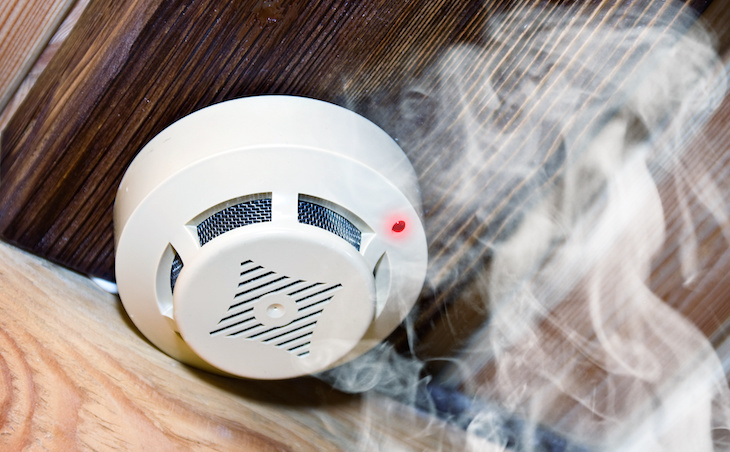Sometimes it feels as though there’s been one emergency situation, one natural disaster, after another. This year alone, there have been wildfires, floods, and hurricanes. With so many natural disasters happening these days, it’s more important than ever to be prepared by having an emergency readiness plan for your home—and your bedroom in particular.
There are things you can do to ensure your bedroom is as secure as possible in an emergency situation. This article will walk you through how to emergency-proof your bedroom for virtually any situation that might present itself.
Home emergency preparedness: assessing your risk
The first step is to assess your particular risk for different emergency situations. You’ll want to do this before moving forward with any of the tips below.
“Assessing risk based on different emergency situations is a crucial skill that can help people make informed decisions to ensure their safety and well-being,” says Peter Duncanson, a restoration and disaster recovery expert with ServiceMaster Restore.
Duncanson says it’s important to understand the nature of the emergency situation you’re facing or might potentially encounter.
This involves “staying informed about potential hazards in your geographical area, such as natural disasters,” he says, adding that it also means “evaluating factors like severity of the event, proximity to the danger zone, and potential for rapid escalation.”
To put potential risks in context, it’s important first to consider where you’re located and what particular risks there might be for your area.
While you won’t have to worry about a tsunami if you live in the Midwest, you should absolutely inform yourself of potential tsunami risks and what to do if you live in Hawaii.
Likewise, if Miami is highly unlikely to suffer a shutdown due to a major snowstorm, it can be at great risk from a hurricane brewing in the Caribbean region.
You should also take into account where in your home the bedroom is located. Is it on the first or second floor? It will be at less risk during a flood if it’s on the second floor, but that location also means you’ll need to define a safe procedure for getting out if there’s a fire.
“Assessing risk based on different emergency situations is a crucial skill that can help people make informed decisions to ensure their safety and well-being.”
Peter Duncanson, a restoration and disaster recovery expert with ServiceMaster Restore
Create and implement an emergency readiness plan
Next, Duncanson advises that you create and implement an emergency preparedness plan based on your risk assessment.
“This plan should include actions to take before, during, and after an extreme weather event, such as evacuation routes, communication plans, emergency supplies, and contact information for emergency services,” he says.
During an actual emergency, Duncanson has this advice: “Stay informed by monitoring reliable information sources like local news, government alerts, and weather updates.”
He adds that you should also be aware of emergency warning systems and community notifications such as text alerts.
It’s important to include all household members in your emergency preparation plan—including small children, seniors, and pets—and to discuss it together.
“Have regular conversations with family members, especially seniors and kids, on how to deal with emergencies,” says Duncanson. “This includes discussing evacuation plans and preparing the home before the worst occurs.”
He also recommends purchasing books that teach family members, especially kids, about handling “scary emergencies.”
How to emergency-proof your bedroom
Your bedroom should be as safe and secure as any other area of your home. So take a bit of extra care to make it safe during sleep.
This means keeping the space clear, uncluttered, and easy to move around to minimize the confusion there can be in an emergency situation.
Gavin Dawson is a board-certified physician assistant and professional wilderness emergency medical technician. His business Global Emergency Medics trains medics for disaster response and wilderness emergencies.
Below, he offers tips to help plan your preparation and responses to various specific types of emergencies, including how specifically to prepare and protect your bedroom for:
Wildfire
Gawson recommends installing smoke detectors to alert you of a fire, placing a fire extinguisher in or outside of your bedroom in case of fire, and practicing fire drills to help you become familiar with your escape routes. This will reduce panic during an actual emergency.
Flood
“At the warning of a flood,” says Gawson, “quickly elevate your bedroom furniture and electrical appliances to prevent water damage and electrical short circuits, shocks, or even fires.”
Unplug electrical appliances from power outlets and install power outlet covers to prevent water from getting into the sockets. You may want to keep your valuables in plastic containers above the floodwater line even when you aren’t expecting a flood.
Earthquake
Nailing frames on the wall and securing heavy furniture to the wall or floors can help keep your bedroom safe during an earthquake.
“This can minimize the risks of objects falling on you while you’re in bed,” says Gawson, “which could cause significant physical harm.”
Hurricane
Bedroom windows and doors should be reinforced with hurricane shutters or plywood to minimize the physical impact of strong winds and heavy rains.
Gawson says it’s a good idea to keep an “emergency stash of food and drinking water” in a sealed container, in case you get stuck in your bedroom.
Tornado
As with a hurricane, the high-powered wind and water are what cause such damage. “A doorway or window opening in your home can allow high-pressure winds outside to force air inside, which can potentially remove a building’s roof,” notes Gawson.
To stay safe, move to the lowest level of your home such as a basement. If you don’t have a basement, a bathtub or the center-most part of your home—perhaps a closet—offers the most protection.
Extended electrical outage
Gawson says during an extended electrical outage, “installing emergency lights and keeping rechargeable fans can help you continue sleeping comfortably in your bedroom.”
You may also want to consider investing in a backup generator or installing solar power. This will “ensure that you have electricity regardless of the climate and local electrical status,” says Gawson.
Home invasion
“To make your bedroom a safe spot during a home invasion,” Gawson says, “install heavy-duty locks on your bedroom.”
He recommends sticking with “the classic knob locks and chain locks to allow easy access or exit during emergencies as other types may be too complicated and time-consuming to use, potentially putting you at even greater risk.”
He also suggests keeping a wireless phone or communication device on your bedside table so you can quickly call the authorities.
How to build an emergency response kit
The Federal Emergency Management Agency (FEMA) recommends keeping a well-stocked emergency kit, or “bug-out” bag as some people call it. FEMA recommends including these items:
- Flashlight with extra batteries
- Small first aid kit
- Emergency whistle
- Small weather alert radio with extra batteries
- Water
- Food
- Cell phone charger and charged power bank
- Prescription medications and necessary over-the-counter medications
- Extra eyeglasses and contact lenses
- Infant supplies, including diapers, wipes, bottles, food
- Pet supplies, including food, water, and any medications
- Cash and credit cards
- Copies of important documents, such as insurance policies, IDs, birth certificates, and bank records or access to an electronic copy saved to the cloud
- Change of clothing and shoes
Gawson adds that a grab-and-go bag (as it’s also known) should contain these same things, but can be further enhanced by adding:
- A multi-tool such as a Swiss Army knife
- A space blanket or sleeping bag
- A face mask
- Matches
- A pen and notepad
Additional tips for an emergency readiness plan for your home
It’s important to note two especially important tips, one related to seniors and the other to any four-legged family members you may have.
“Many seniors may find it difficult to flee quickly in an emergency,” says Sharon Cooksey, a residential fire safety expert and consumer educator.
For this reason, she advises to “keep glasses, phones, wheelchairs, canes, and hearing aids close to the bed to be accessible.” She also suggests you keep a whistle, flashlight, cell phone, and charger close to the bed if you need to call or signal for assistance.
As for the household pets, Cooksey says pet parents should prepare in advance in case of emergency.
“Emergencies often accompany the blaring sounds of alarms, and these noises can be frightening for pets,” she says. The thing pet parents do not want to happen is for a pet to run or hide. Training methods are available that help to desensitize pets to the alarm sounds and teach them what to do when they hear alarms.”
FAQs
How can you make your bedroom earthquake-safe?
You can start by making sure you know how to exit your bedroom and your home to get out quickly. Don’t hang heavy objects—such as art or shelving units—above the bed, where they could become loose and fall on you during an earthquake.
Anchor top-heavy pieces of furniture to studs in the wall or to the floor so they don’t tip over. Secure small objects—such as books, knick-knacks, fans, or appliances—if they could potentially fall onto the sleeping area. Move any heavy items at more than four feet above the ground to a lower location on the floor.
What should you do if there’s an earthquake while you’re in bed?
If you’re in bed and have no time to drop to the floor, ready.gov recommends you turn face down on the bed and cover your head and neck with a pillow.
Wildfire smoke can lead to poor air quality in your home. Here’s how to improve the air quality in your bedroom.




